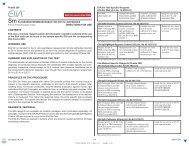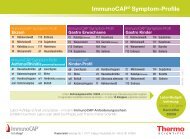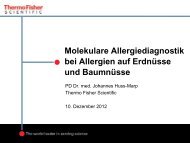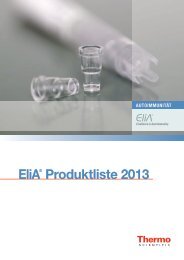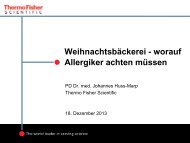ImmunoCAP Nut Components ImmunoCAP Nut Components - Phadia
ImmunoCAP Nut Components ImmunoCAP Nut Components - Phadia
ImmunoCAP Nut Components ImmunoCAP Nut Components - Phadia
Create successful ePaper yourself
Turn your PDF publications into a flip-book with our unique Google optimized e-Paper software.
<strong>ImmunoCAP</strong><br />
<strong>Nut</strong> <strong>Components</strong>
<strong>Nut</strong> allergies are increasing<br />
<strong>Nut</strong>s have become popular nutritional snacks.<br />
In parallel, the number of nut allergic patients<br />
is increasing.
<strong>Nut</strong> allergies differ from<br />
person to person …<br />
Find out which nuts your patient<br />
can or cannot eat!
… and from nut to nut<br />
• <strong>Nut</strong>s contain different allergen components.<br />
• The components belong to different protein families,…<br />
• where some are clinically more important than others.
<strong>Nut</strong> allergens<br />
• <strong>Nut</strong>s contain several allergenic molecules,<br />
some are clinically more important than others.<br />
• The molecules belong to different protein families<br />
with varying degree of stability and homology.<br />
• The clinical consequences of being sensitized to<br />
them therefore differ.
Some components may cause<br />
severe systemic reactions while<br />
others are linked to tolerance.
Some components may cause<br />
allergy due to cross-reactivity<br />
while others do not.
<strong>ImmunoCAP</strong> <strong>Nut</strong> components<br />
Profilin PR-10 protein LTP Storage Proteins<br />
PEANUT<br />
Profilin Ara h 8 Ara h 9<br />
Ara h 1<br />
Ara h 2<br />
Ara h 3<br />
HAZEL NUT<br />
Profilin Cor a 1 Cor a 8<br />
Cor a 9<br />
Cor a 14<br />
WALNUT<br />
Profilin Jug r 3 Jug r 1<br />
BRAZIL NUT<br />
Profilin Ber e 1<br />
CASHEW NUT<br />
Profilin Ana o 3
Storage proteins<br />
• A family of proteins abundant in nuts,<br />
seeds and legumes.<br />
• Relatively species specific. Cross-reactivity<br />
is usually limited to botanically closely<br />
related species such as walnut-pecan or<br />
cashew – pistachio.<br />
• Stable to both heat and digestion, and<br />
can therefore cross the gastrointestinal<br />
mucosa intact and cause systemic<br />
reactions.<br />
Cor a 9<br />
Cor a 14<br />
Jug r 1<br />
Ara h 1<br />
Ara h 2<br />
Ara h 3<br />
Ber e 1<br />
Ana o 3
Lipid Transfer Proteins (LTP)<br />
• A family of proteins present in plant foods,<br />
tree and weed pollen.<br />
• Food LTPs are found in various fruits,<br />
nuts and vegetables.<br />
• The degree of cross-reactivity within<br />
this family varies.<br />
• Stable to heat and digestion, and can<br />
therefore give rise to systemic reactions.<br />
Ara h 9<br />
Cor a 8 Jug r 3<br />
Pru p 3
PR-10 proteins*<br />
• A family of proteins found in tree pollen<br />
and foods from plant origin.<br />
• The major birch pollen allergen Bet v 1<br />
is a PR-10 protein.<br />
• The degree of cross-reactivity within this<br />
family varies.<br />
• PR-10 proteins are heat and digestion labile.<br />
• IgE antibodies to food PR-10 primarily result<br />
in local clinical reactions.<br />
Cor a 1<br />
Mal d 1<br />
Ara h 8<br />
Bet v 1<br />
*Pathogenesis-related Group 10
Profilins<br />
• A family of proteins found in species from the<br />
plant kingdom, like pollen, plant food or latex.<br />
• Profilins show extensive IgE cross-reactivity.<br />
• Profilin sensitization is common among grass<br />
pollen allergic patients.<br />
• Profilins are heat and digestion labile.<br />
• IgE antibodies to profilin primarily result<br />
in no or local clinical reactions.<br />
Phl p 12<br />
Gly m 3<br />
Ara h 5<br />
Bet v 2<br />
Cor a 2
Increasing risk of systemic reactions<br />
Profilin PR-10 protein LTP Storage Proteins<br />
PEANUT<br />
Profilin Ara h 8 Ara h 9<br />
Ara h 1<br />
Ara h 2<br />
Ara h 3<br />
HAZEL NUT<br />
Profilin Cor a 1 Cor a 8<br />
Cor a 9<br />
Cor a 14<br />
WALNUT<br />
Profilin Jug r 3 Jug r 1<br />
BRAZIL NUT<br />
Profilin Ber e 1<br />
CASHEW NUT<br />
Profilin Ana o 3
Increasing homology and cross-reactivity<br />
Storage Proteins LTP PR-10 protein Profilin<br />
PEANUT<br />
Ara h 1<br />
Ara h 2<br />
Ara h 3<br />
Ara h 9 Ara h 8 Profilin<br />
HAZEL NUT<br />
Cor a 9<br />
Cor a 14<br />
Cor a 8 Cor a 1<br />
Profilin<br />
WALNUT<br />
Jug r 1 Jug r 3 Profilin<br />
BRAZIL NUT<br />
Ber e 1<br />
Profilin<br />
CASHEW NUT<br />
Ana o 3<br />
Profilin
Find out which component<br />
your patient is sensitized to.<br />
Ara h 1 Ara h 2<br />
Ara h 8<br />
Ara h 9 Ara h 3
Testing step by step<br />
Step 1: Patient history<br />
Step 2: <strong>ImmunoCAP</strong> whole allergen test<br />
Step 3: <strong>ImmunoCAP</strong> allergen component test
Peanut (f13)<br />
Ara h 1 + Ara h 2 + Ara h 3<br />
(f422) (f423) (f424)<br />
Ara h 9 (f427)<br />
Ara h 8 (f352)<br />
• Storage proteins<br />
• Stable to heat and digestion<br />
• Associated with severe reactions<br />
• Lipid transfer protein (LTP)<br />
• Stable to heat and digestion<br />
• Associated with both severe<br />
and local reactions<br />
• Associated with allergy to<br />
peach and peach related<br />
fruits<br />
• PR-10 Protein<br />
• Labile to heat and digestion<br />
• Associated with local<br />
reactions<br />
• Associated with allergy to<br />
birch and birch related tree<br />
pollens
Hazelnut (f17)<br />
Cor a 9 (f440) + Cor a 14 (f439)<br />
Cor a 8 (f425)<br />
Cor a 1 (f428)<br />
• Storage proteins<br />
• Stable to heat and digestion<br />
• Highly abundant in hazelnut<br />
• Associated with severe reactions<br />
• Lipid transfer protein (LTP)<br />
• Stable to heat and digestion<br />
• Associated with local as well<br />
as systemic reactions<br />
• PR-10 protein<br />
• Labile to heat and digestion<br />
• Associated with local reactions
Walnut (f256)<br />
Jug r 1 (f441)<br />
Jug r 3 (f442)<br />
• Storage protein (2S albumin)<br />
• Heat and digestion stable<br />
• Highly abundant in walnut<br />
• Associated with systemic reactions<br />
• Lipid transfer protein (LTP)<br />
• Heat and digestion stable<br />
• Associated with local as well as<br />
systemic reactions
Brazil nut (f18)<br />
Ber e 1 (f354)<br />
• Storage protein (2S albumin)<br />
• Heat and digestion stable<br />
• Highly abundant in brazil nut<br />
• Associated with systemic reactions
Cashew nut (f202)<br />
Ana o 3 (f443)<br />
• Storage protein (2S albumin)<br />
• Heat and digestion stable<br />
• Highly abundant in cashew nut<br />
• Associated with systemic reactions
Can component testing tell<br />
two different stories<br />
Caroline and Emma, 16 years old
Similar patient histories and SPT…<br />
• Rhinitis and conjunctivitis<br />
during pollen season.<br />
• Nasal obstruction, itchy eyes<br />
and oral local reaction after<br />
peanut intake.<br />
Caroline<br />
Emma<br />
SPT results: Peanut +4 ✔ ✔<br />
Diagnosis: Peanut allergy ✔ ✔<br />
Treatment: Peanut<br />
avoidance<br />
✔<br />
✔
Similar <strong>ImmunoCAP</strong><br />
Complete results …<br />
Peanut Caroline Emma<br />
f13 (kU A /l) 26 28
…but different component IgE profiles<br />
Profilin PR-10 protein LTP Storage Proteins<br />
Ara h 8<br />
Caroline 33<br />
Emma 10.3<br />
Ara h 9<br />
Ara h 1<br />
Caroline
Emma needs to avoid peanuts.<br />
Caroline doesn’t.<br />
Emma<br />
Caroline<br />
Diagnosis: Peanut allergy No peanut allergy<br />
Treatment: Dietary restriction No dietary restriction
<strong>ImmunoCAP</strong> <strong>Nut</strong> <strong>Components</strong><br />
help you assess the clinical<br />
risk of reactions
<strong>ImmunoCAP</strong> <strong>Nut</strong> <strong>Components</strong><br />
help you differentiate between<br />
primary allergies and allergy<br />
due to cross-reactivity.
<strong>ImmunoCAP</strong> <strong>Nut</strong> <strong>Components</strong><br />
help you give relevant advice<br />
and define the optimal<br />
treatment.
Find out more with<br />
<strong>ImmunoCAP</strong> <strong>Nut</strong> <strong>Components</strong><br />
• Help you to assess the clinical risk of reactions by<br />
precise quantitative measurement of IgE antibodies.<br />
• Help you differentiate between primary allergies<br />
and allergy due to cross-reactivity.<br />
• Helps you give relevant advice and define the<br />
optimal treatment.<br />
• Helps you improve the patient’s well-being and<br />
quality of life.
Find out more with<br />
<strong>ImmunoCAP</strong> <strong>Nut</strong> <strong>Components</strong>




